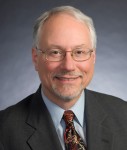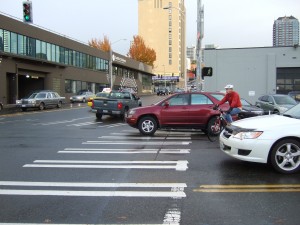In Crosscut, Roger Valdez looks at the impacts of traditional sidewalks on the environment. A Washington State Department of Transportation study unsurprisingly shows a benefit from installing sidewalks.
Here’s the key paragraph from the study:
The results provide early evidence in the potential effectiveness of sidewalks to reduce CO2 and VMT [vehicle miles traveled], in addition to a mixed land use pattern, shorter transit travel and wait times, lower transit fares and higher parking costs. Sidewalk completeness was found to be marginally significant (at the 10 percent level) in reducing CO2, and insignificant in explaining VMT.
In this sense the term “marginally” might read as “small.” But in a research context “marginally significant” also means sidewalks can make a difference along with other factors to significantly reduce CO2 emissions.
However, pavement is impermeable, blocking rainwater from being absorbed by the ground and redirecting it to the storm sewers that send it to Puget Sound.
After it rains, water hits all that pavement and it starts rolling around, picking up the petroleum drippings from cars, pesticides from lawn care products, and a legion of other things that end up harming fish and other creatures trying to survive in urban creeks and streams. Ultimately, all that water winds up in the Puget Sound, where the Partnership for Puget Sound says at least two species of salmon are threatened with extinction because of stormwater runoff.
Valdez supports natural drainage systems, like the one installed on NW 110th St. These narrow the roadway and include landscaping to collect rainwater runoff, reducing the amount of rainwater and pollutants channeled into the Sound.
The project that Valdez references was constructed by Seattle Public Utilities whereas most sidewalks are constructed by SDOT.
However, the city’s 2009 Stormwater Code requires SDOT to consider green stormwater infrastructure. SDOT spokesperson Marybeth Turner says:
This means that where space is available and it is technically feasible, elements such as bioretention swales, porous sidewalk, and new street trees are required to be installed adjacent to the new sidewalk in the planting strip between the sidewalk and street. These measures are meant to infiltrate or reduce the surface water generated from the impervious surface of the sidewalk before it reaches the gutter and eventually the drainage system and Puget Sound.
There are several current SDOT sidewalk projects that include green stormwater infrastructure elements. On these projects, SPU is “providing guidance with respect to maintenance requirements and direction on standards requirements.” These projects include NE 55th and Ravenna intersection improvements, Linden Ave N Complete Streets Project, and “numerous neighborhood sidewalk projects funded by the Bridging the Gap transportation initiative,” according to Turner.
While these sidewalks take cues from the green drainage designs that SPU has developed, this design cannot be applied everywhere. “The space may not be available, the pollutant loading too great, the soils may not be conducive, and there are in most cases numerous other utilities which may be in conflict,” Turner says
Still, it’s good to know that the city is working to limit negative side effects of new sidewalk construction. Now, if only they could build more of them.
 Walking in Seattle is running a series to showcase the perspectives of prominent walkers in the city. This week’s Q&A is with Seattle City Council President Richard Conlin:
Walking in Seattle is running a series to showcase the perspectives of prominent walkers in the city. This week’s Q&A is with Seattle City Council President Richard Conlin:

 Walking in Seattle is running a series to showcase the perspectives of prominent walkers in the city. This week’s Q&A is with Seattle City Council Member Tim Burgess:
Walking in Seattle is running a series to showcase the perspectives of prominent walkers in the city. This week’s Q&A is with Seattle City Council Member Tim Burgess:

